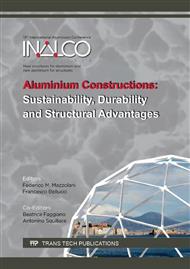p.402
p.409
p.415
p.421
p.427
p.433
p.439
p.445
p.451
Recent Development of Codes for Design of Aluminum Structures in Canada
Abstract:
In 2011, a new chapter was added to the Canadian Highway Bridge Design Code (CAN/CSA S6) [1] enabling the design of aluminum bridge components and structures in Canada. In 2016, activities are well underway, which will result in significant modifications to the Canadian aluminum structures code: “Strength Design in Aluminum” (CAN/CSA S157) [2] and the Canadian code for welding of aluminum structures: “Welded Aluminum Construction” (CAN/CSA W59.2) [3]. This paper discusses the philosophies employed in the development and modernization of these design codes and highlights some of the major changes to these codes. In the case of CAN/CSA S6, the new aluminum chapter was basically written from scratch. However, a practical approach was employed of using material from existing codes, where appropriate (including CAN/CSA S157, the AASHTO Bridge Design Specification [4], the U.S. Aluminum Design Manual [5], and the Eurocode [6]), and organizing the chapter to resemble as closely as possible the chapter for steel bridge structures, so that designers would be relatively comfortable with the new material. In the case of CAN/CSA S157, a significant reorganization of the code contents will be occurring in the latest edition, in order to bring it closer to the Canadian steel structures code (CAN/CSA S16) [7] where possible, again to make the code more user friendly. In the case of the aluminum welding code (CAN/CSA W59.2), changes are being considered to allow the use of technologies such as friction stir welding (FSW) and post-weld treatments (e.g. peening, grinding) for improving fatigue performance. This work is being done with input from Canadian industry experts and academics, in consultation with international experts from the U.S. and Europe. It is expected that this work will lead to substantially improved design codes, resulting in significant benefits in terms of the economics and safety implications of designing aluminum structures in Canada.
Info:
Periodical:
Pages:
451-457
Citation:
Online since:
September 2016
Authors:
Price:
Сopyright:
© 2016 Trans Tech Publications Ltd. All Rights Reserved
Share:
Citation:


